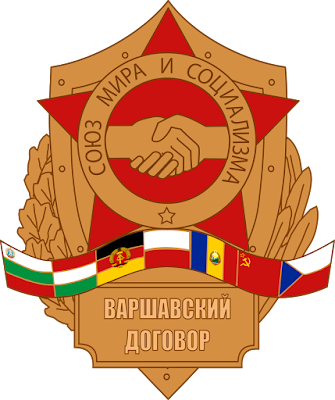The Warsaw Pact
The Warsaw Pact, was a collective defence treaty signed in Warsaw among the Soviet Union and seven Soviet satellite states of Central and Eastern Europe during the Cold War. It was created in reaction to the integration of West Germany into NATO in 1955, but it is also considered to have been motivated by Soviet desires to maintain control over military forces in Central and Eastern Europe.
 There was no direct confrontation between them. Instead, the conflict was fought on an ideological basis and in proxy wars. Both NATO and the Warsaw Pact led to the expansion of military forces and their integration into the respective blocs. The Pact began to unravel in its entirety with the spread of the Revolutions of 1989 through the Eastern Bloc, beginning with the Solidarity movement in Poland and its electoral success in June 1989. East Germany withdrew from the Pact in 1990. On 25 February 1991, the Pact was declared at an end at a meeting of defence and foreign ministers from the six remaining member states in Hungary. The USSR itself was dissolved in December 1991, although most of the former Soviet republics formed the Collective Security Treaty Organization shortly thereafter. Throughout the following 20 years, the seven Warsaw Pact countries outside the USSR each joined NATO (East Germany through its reunification with West Germany; and the Czech and Slovak republics as separate countries).
There was no direct confrontation between them. Instead, the conflict was fought on an ideological basis and in proxy wars. Both NATO and the Warsaw Pact led to the expansion of military forces and their integration into the respective blocs. The Pact began to unravel in its entirety with the spread of the Revolutions of 1989 through the Eastern Bloc, beginning with the Solidarity movement in Poland and its electoral success in June 1989. East Germany withdrew from the Pact in 1990. On 25 February 1991, the Pact was declared at an end at a meeting of defence and foreign ministers from the six remaining member states in Hungary. The USSR itself was dissolved in December 1991, although most of the former Soviet republics formed the Collective Security Treaty Organization shortly thereafter. Throughout the following 20 years, the seven Warsaw Pact countries outside the USSR each joined NATO (East Germany through its reunification with West Germany; and the Czech and Slovak republics as separate countries). 
Comentarios
Publicar un comentario